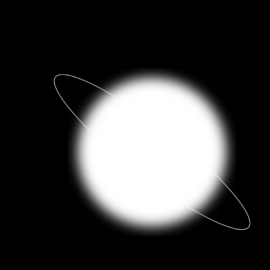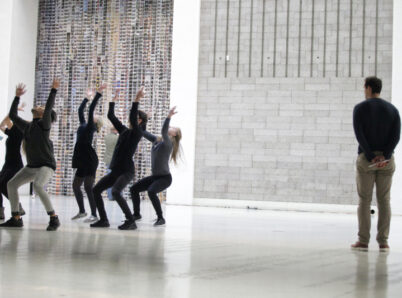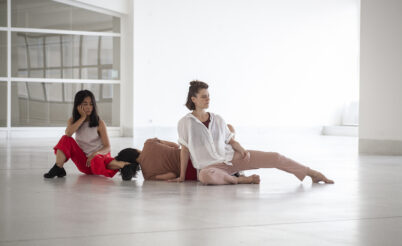
Gallery Without Borders: Eleven Artists, One Shared Space
Extraordinary project Gallery without Borders hosted a research of eleven dance makers from the Czech Republic and the USA who, together with American choreographer Sue Schroeder, explored the role of the artistic artefact and its kinesthetic potential in the gallery – white cube space. Various movement researches were applied and reflected the display and curatorial ideas of the current exhibition Art of Long Century: 1796–1918 in the National Gallery Prague. The outcome of this long-term quarantine research was presented live in the National Gallery Prague and streamed on 14 July 2020. Here you can follow more on why these eleven movement artists decided to attend this particular project.
19th Century (wo)Man: A Contemporary Intervention
Participating Artists: Walter Apps (USA), Barbora Látalová (CZ), Roman Zotov Mikshin (RU), Nikki Morath (USA), Johana Pocková (CZ), Joshua Rackliffe (USA), Benjamin (Benji) Lee Stevenson (USA), Eva Urbanová (SK/CZ), Zdenka Brungot Svíteková (SK/NO/CZ)
Walter Apps (USA)
Contemporary ballet dancer, lives and works in New York, performed with Aszure Barton, Septime Webre, Lar Lubovitch, MADBOOTS, and Ohad Naharin. He is currently a dance artist with Core Dance, based in Atlanta, GA and Houston, TX.
What is your current interest/curiosity in your movement/choreographic research?
I am most interested in visual/performance art that provokes an audience to see from a different perspective and engage in questions. The realistic human sparks my curiosity. The versatile performer/dancer sparks my curiosity. Blending the two is a choreographic research that I’m interested in.
What are you most interested/curious about for this project?
I am delighted to work with international artists. I believe this experience will enrich my view on visual art through collaboration. I am also very excited to showcase the change in art during the Long Century. The way artists blended old ideas with new interests me, because I am currently researching how to do that in the medium of performance.
Barbora Látalová (CZ)
Freelance dancer, actor, teacher and choreographer, co-founder of OSTRUŽINA z.s., free artistic association – www.ostruzina.eu
What is your current interest/curiosity in your movement/choreographic research?
I am writing you the three things I now find in my head, because without your question I am not in the process of working on them – I just have them in my pockets.
I am describing to you something I’m interested in when I watch people dancing.
First: I am actually looking at patterns of people’s movements – not in the sense of abandoning them, but in the sense of understanding why they exist and what they are. The step before we want to get rid of them is to explore or allow them – to first recognise them and enjoy them. I am fascinated when I can define someone’s movement and say: “This is your movement – I know it.”
And the opposite: it is a bit hard to say that to myself, because usually when I recognise my own movement, I’d rather escape from it – I don’t want to repeat it… So now I’m challenging myself to work with what I already know in my way of moving. And I’m curious – why am I fascinated when I recognise movement in others, and not fascinated when I recognise it in myself? 🙂
The second thing is connected – still to people’s movements, gestures and pop culture. Why do certain songs lead people to the same expressions in movement? Like raising hands, turning, hopping, screaming together with a singer. Very often a specific song leads into a similar mood of movement and gestures. I haven’t researched it yet – it’s just in my head since Christmas when I was in a crowd of dancing people. Connection to emotions of sound, special time, and groups of people – even from different backgrounds.
The last is a concept I started and then abandoned – angularity versus rotundity – starting from the painting inspiration of Austrian painter and activist Friedensreich Hundertwasser. And while writing this, a question I always have comes up again: is it possible to do everything with dance? Yes – or are there themes that are closer to it or not? If yes, I still think we have to find an entry point into it that is compatible with what dance can say about it – and it will still stay dance.
What are you most interested/curious about for this project?
Sue – first it’s you. And then Liz Lerman’s Critical Response Process – I’m very much looking forward to that. I worked with Bush Hartshorn, who was a coach several times, and he introduced us to this technique. But this time, with you, it will be the first time to apply it to my own work.
And thanks to the current COVID situation, I am very much looking forward to the technological part of the project – even though I am very bad at using it. Now I see how important it is, and that people with knowledge are much more adaptable. It will be kind of a spaceship adventure.
(I even realised for the first time in my life that I really need a car and driving lessons – how much easier life would be now…)
So this stream of thoughts leads me back to the area of my choreographic interest as well: independence, self-sufficiency.
It has been a kind of paradox – in this situation of isolation, the needs of society and connection are very visible. And thanks to that, I realise how much I don’t allow myself to know – because most of my time before was caring for others (family, children in school where I’ve taught for many years, people in our company, audience in our performances, colleagues…). And through this way of caring, they also care about me – and I need them to exist.
Now I’m in my flat with my almost grown-up child and dog, and it’s challenging to be only with myself. I realise how many things I hide or ignore inside. I have to learn again how to communicate, how to work with time, how to find time for relaxation. And mostly, I learn that I’m not doing this – I don’t have the skills…
How very difficult it is to do everything almost without help of others… And how much I need reflection and immediate live feedback. To be alone is not easy – and I hope it will make us stronger human beings.
So this project, at this moment, allows me to still be only with myself – I have to help myself to be self-sufficient. And at the same time, I know I will do it with a group of people I like and am interested in – and finally I will experience the global need and practical use of technologies, the work, to feel again the sense of creation and to feel I’m part of something creative.
Roman Zotov Mikshin (RU)
Freelance dancer based in Prague, works with physical, visual and dance theatre.
What is your current interest/curiosity in your movement/choreographic research?
My current interest is in the ability to create a durational piece (365 minutes), ideally for the white-cube gallery space, where everything – a human body, time, music, different sorts of objects from daily life – will be presented as phenomena, as something to be objectified and presented in the gallery space. I am very curious to present the creation and search process as a “piece of art” also.
What are you most interested/curious about for this project?
As I said in our personal meeting, I’m very excited that my current interest, as I described in 2), is very similar to what you presented at our meeting. I’m also very interested in trying a new approach: not directly reflecting the work of art, but rather the intention of the artist. I find it a very inspiring and curious path.
Really looking forward and preparing myself for exciting work 🙂
Nikki Morath (USA)
Contemporary dancer currently working with Core Dance company.
What is your current interest/curiosity in your movement/choreographic research?
Currently, I adore the rigour of technique and aim to unveil the truth that pours out from the moving body. My passion for movement has evolved into a desire to engage communities in experiences rooted in performance art. I am devoted to developing experiences that fuse performance art and the human experience.
What are you most interested/curious about for this project?
Aha! I am most interested in how this creative project will evolve! I’m excited by the challenge of the virtual portion and feel anticipation for being in the same space for the second part of this project. I’m looking forward to the transfer of information and the collaboration we have ahead!
Johana Pocková (CZ)
Freelance dancer based in Prague. Awarded the Jarmila Jeřábková Award 2017. In May 2019, she founded the company POCKetART. As a performer, she collaborates with Tantehorse company and Cirk La Putyka.
What is your current interest/curiosity in your movement/choreographic research
Recently I’ve been interested in movement research aimed at original physicality inspired by human senses. I’m looking for a way to awaken viewers’ senses through dancers’ bodies. Also, within my research, I try to “animate” artificial objects – to give them the possibility to be perceived as natural organisms. This relates to the upcoming research inspired by paintings – the artistic intention of the artists and their works.
How can we animate the “inanimate” painting (which is actually very moving in stillness) using our bodies? How can we relate to the story of a painting, which has its own time?
Another aspect of my current interest is the specific atmosphere – calmness, concentration and time – that we find in gallery space. My question is: can I bring this specific atmosphere into another (theatre) space?
What are you most interested/curious about for this project?
I had a chance to work with a painting from Art of the Long Century: 1796–1918 in Veletržní palác – National Gallery last summer, thanks to a SE.S.TA choreographic residency with coaching. I spent an hour mirroring with one painting. Gallery spectators were passing by, but I was also alone there for some time. Time seemed to stop, and the painting uncovered another layer of its meanings – or my imagination. These were very interesting moments of finding a relationship to it.
So my interest and curiosity in this project lies in researching ways of creating a unique kinesthetic relationship with the art. How can I do that without copying the story of the painting, but instead find a way to relate to it? Philosophically, historically, visually, atmospherically, architecturally… etc.
I’m happy to be inspired by dancers from America and my colleagues from the Czech Republic – to be part of common discussions and share different points of view. I’m very interested in being led by the virtual concept and choreographer Sue, and to experience a live-stream performance from two continents. I hope Part II will also be realised in the future.
Looking forward to meeting you all online and starting our creative process.
Joshua Rackliffe (USA)
Movement artist from Mableton, GA. Currently a Dance Artist at Core Dance, where he has worked ever since. Joshua also performs as a cabaret entertainer under the alter ego “Brigitte Bidet”.
What is your current interest/curiosity in your movement/choreographic research?
Currently, I’m really curious about the body as a kinesthetic sculpture and how this sculpture is presented to an audience. As quarantine has pushed us online, there has been a lot of research into how best to “broadcast” art to the digital space. The artist has a unique advantage here – the ability to control the viewer’s gaze is much more available. This informs the style of movement and creates new limitations for dance as a performing art.
What are you most interested/curious about for this project?
I’m most interested in being exposed to new creative processes and perspectives that can only be learned through collaboration. The international component excites me greatly. The more I work with artists from around the world, the more I see the common threads that inspire us as humans – but also the special ideas that make our cultures different. Dialogue and shared learning are what I seek most.
Rose Shields (USA)
Performs acrobatics and aerials as a freelancer with various local groups. Currently in her 7th season with Core Dance.
What is your current interest/curiosity in your movement/choreographic research?
My current interest lies in the body’s potential and capability to offer complex and dynamic movements and shapes, as well as in exploring the possibilities of balance and movement in partnership with other bodies – new ways to lift and be lifted (or support and be supported).
I’ve been playing with the fundamentals of physics (mechanics) in relation to the human body’s structure and physical capabilities (acrobatics, to sum up), but in a thoughtful way that is approachable and linked to subject matter – like architecture or a historical moment such as Božena Laglerová becoming the first licensed Czech female pilot in 1911.
(Source: radio.cz article)
What are you most interested/curious about for this project?
I’m really interested in the sculptures within the exhibit (from the few I saw online) – and how they are displayed in relation to neighbouring paintings. What debates or thoughts might this provoke about the connections between history and the present day?
I’m also excited to work with other artists, hear about their ideas, and explore ways to collaborate and create multifaceted performance art?
Benjamin (Benji) Lee Stevenson (USA)
Movement artist and published poet from rural Alabama, currently based in Atlanta, Georgia, where they work with Core Dance.
What is your current interest/curiosity in your movement/choreographic research?
I’m currently interested in using text – poetry and prose – as movement prompts to evoke honest physical states of being, as well as imagery drawn by the body. More broadly, I’m interested in improvisation as a performance tool, confessional poetry, surrealism, and dance theatre.
What are you most interested/curious about for this project?
First and foremost, I’m always excited about working with other artists and collaborative processes. I’m particularly interested in projects like this, which require us to source inspiration from non-performance-based artworks – visual art and literature. I really enjoy the challenge of trying to convey a feeling, sentiment, or concept through movement that might have previously been conveyed in another form.
Eva Urbanová (SK/CZ)
Freelance dancer based in Prague. She has worked with Japanese choreographer Yukio Suzuki, Slovak choreographer Petra Fornayová, among others.
What is your current interest/curiosity in your movement/choreographic research?
At the moment, I am in the process of creating my MA thesis choreography. This project will be performed in a gallery space – not because I want to bring dance into a gallery, but because I want to allow the audience to perceive the human dancing body in a different interior than the theatre stage. This might bring the audience new perspectives on the moving body, or allow them to experience something they might not feel when watching the piece in a theatre space.
In this work, I am also exploring the following elements:
– The human body as a statue (not sure if this is the right term… but for now I will use it)
– The audience as part of the moving picture (audience will be able to move freely in the space)
– Time
– Human touch
What are you most interested/curious about for this project?
I am very interested in the exchange of ideas among artists, which I believe is a necessity in order to move forward and beyond my own habits of thinking and creating. I am curious whether I can surprise myself with a new perspective on sensing space – a memory I can later use in my own creative process.
Scott Wheet (USA)
Born and raised in Chicago, Illinois. He has received mentorship from Kristin O’Neal, Dominique Angel, Kyle Abraham, Tracy Gilland, Claudia Lavista, Jen Nugent, Robbie Cook, and others. Currently a full-time Dance Artist with Sue Schroeder/Core Dance.
What is your current interest/curiosity in your movement/choreographic research?
I like to focus on researching feelings and ideas that sit close to my heart. As a mover, I believe that crafting from improvisation, raw impulses, pleasure, and joy is fundamentally important. In the creative scene, visual performance art has become an increasingly stimulating phenomenon for me. I’m often thinking about how I can synthesise static imagery with movement that is personal and confident – and use materials that speak strongly to myself or physical spaces – all in order to build installations that are radically surreal and brutally rooted in reality.
In addition, topics of identity, intimacy, and loss have been sifting through my body for the past year or so. I wish most deeply for an opportunity to choreograph work that allows me to discover my deepest self while nurturing environments where the people around me can do the same.
What are you most interested/curious about for this project?
The first and most important goal for me is to discover the rich and unique history of Czech visual art. From there, I want to identify parallels between my research and subjects that defy time. For me, working in solo form is less familiar, and therefore vitally important to my journey as a creative. I also look forward to creating something provocative and exciting with new friends!




